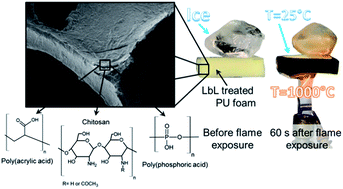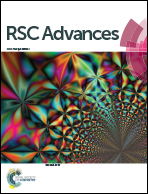Self-assembled hybrid nanoarchitectures deposited on poly(urethane) foams capable of chemically adapting to extreme heat†
Abstract
In the present paper the layer by layer (LbL) technique has been adopted for the construction of hybrid organic–inorganic nanoarchitectures capable of adapting to extreme heat or flame exposure and chemically evolving into thermally-stable carbon based structures. More specifically, the LbL technique has been applied to an open cell poly(urethane) (PU) foam in order to increase its thermal and flame stability. Scanning electron microscopy showed that the LbL assembly covered each surface of the PU complex three-dimensional structure without altering its open cell morphology. When exposed to a direct flame, the treated PU foam was capable of stopping combustion within a few seconds after ignition, unlike the untreated foam that burned completely. Under different irradiative heat fluxes (from 35 up to 75 kW m2), the coating demonstrated exceptional performances by reducing the rate of heat release up to 60% with respect to the untreated counterpart. Finally, when subjected to a flame torch penetration (Tflame ≈ 1300 °C), the LbL-coated PU foam was capable of maintaining its three-dimensional structure, thus successfully insulating the unexposed side (T below 100 °C after two flame torch applications) with temperature drops of 800 °C achieved with a specimen thickness of only 10 mm.


 Please wait while we load your content...
Please wait while we load your content...